
28. díszsor
Csemegi Károly síremléke, márvány (carrarai), 1902 (28- díszsor-1)
Szobrász: Donáth Gyula (1850−1909)
 Csemegi Károly síremlékének főalakja, Justitia, az igazság istennője, aki bal kezével megérinti Csemegi homlokát, jobbjában pedig kardot és égő fáklyát tart, amellyel a felső részre vésett feliratot világítja meg. A síron szereplő „1878. V.” felirat az 1878. évi V. törvénycikkre utal, amely életre hívta az első magyar nyelvű büntető törvénykönyv, közismert nevén a Csemegi-kódex. Így tehát már az is érthető, hogy Donáth miért éppen az igazság római istennőjének szobrát faragta a jogász sírjára. Donáth Gyula funerális művészetében gyakran találkozunk az antik mitológiák szereplőivel, Huszár Adolf sírjára a Moirák egyikét, Athropost, Kamermayer Károlyéra a történelem múzsáját, Kliót, Péterfy Jenőére pedig Minerva alakját formázta meg.
Csemegi Károly síremlékének főalakja, Justitia, az igazság istennője, aki bal kezével megérinti Csemegi homlokát, jobbjában pedig kardot és égő fáklyát tart, amellyel a felső részre vésett feliratot világítja meg. A síron szereplő „1878. V.” felirat az 1878. évi V. törvénycikkre utal, amely életre hívta az első magyar nyelvű büntető törvénykönyv, közismert nevén a Csemegi-kódex. Így tehát már az is érthető, hogy Donáth miért éppen az igazság római istennőjének szobrát faragta a jogász sírjára. Donáth Gyula funerális művészetében gyakran találkozunk az antik mitológiák szereplőivel, Huszár Adolf sírjára a Moirák egyikét, Athropost, Kamermayer Károlyéra a történelem múzsáját, Kliót, Péterfy Jenőére pedig Minerva alakját formázta meg.
Donáth Gyula a sírszobrot a Csemegi Károly iránti tisztelete jeléül díjmentesen készítette el.
Péterfy Jenő síremléke, márvány, 1901 (28-1/a-15)
Szobrász: Donáth Gyula (1850−1909)
Donáth Gyula 1901-ben több síremléken is párhuzamosan dolgozott. Az egyik a polgármester Kamermayer Károlyé, a másik pedig a tanár és művészettörténész Péterfy Jenőé volt. A két síremlék leleplezése között is csupán pár nap telt el. Péterfy Jenő életének utolsó tíz évében a görög nyelv tanulásával és a görög irodalom történetével foglalkozott. Síremléke utolsó nagy szerelme, a görög eszmevilág egyik ikonikus alakját, Pallasz Athénét ábrázolja. Az istennő fején sisak, mellén páncél, jobb kezében fáklya, baljában pajzs, rajta Péterfy arcképe. 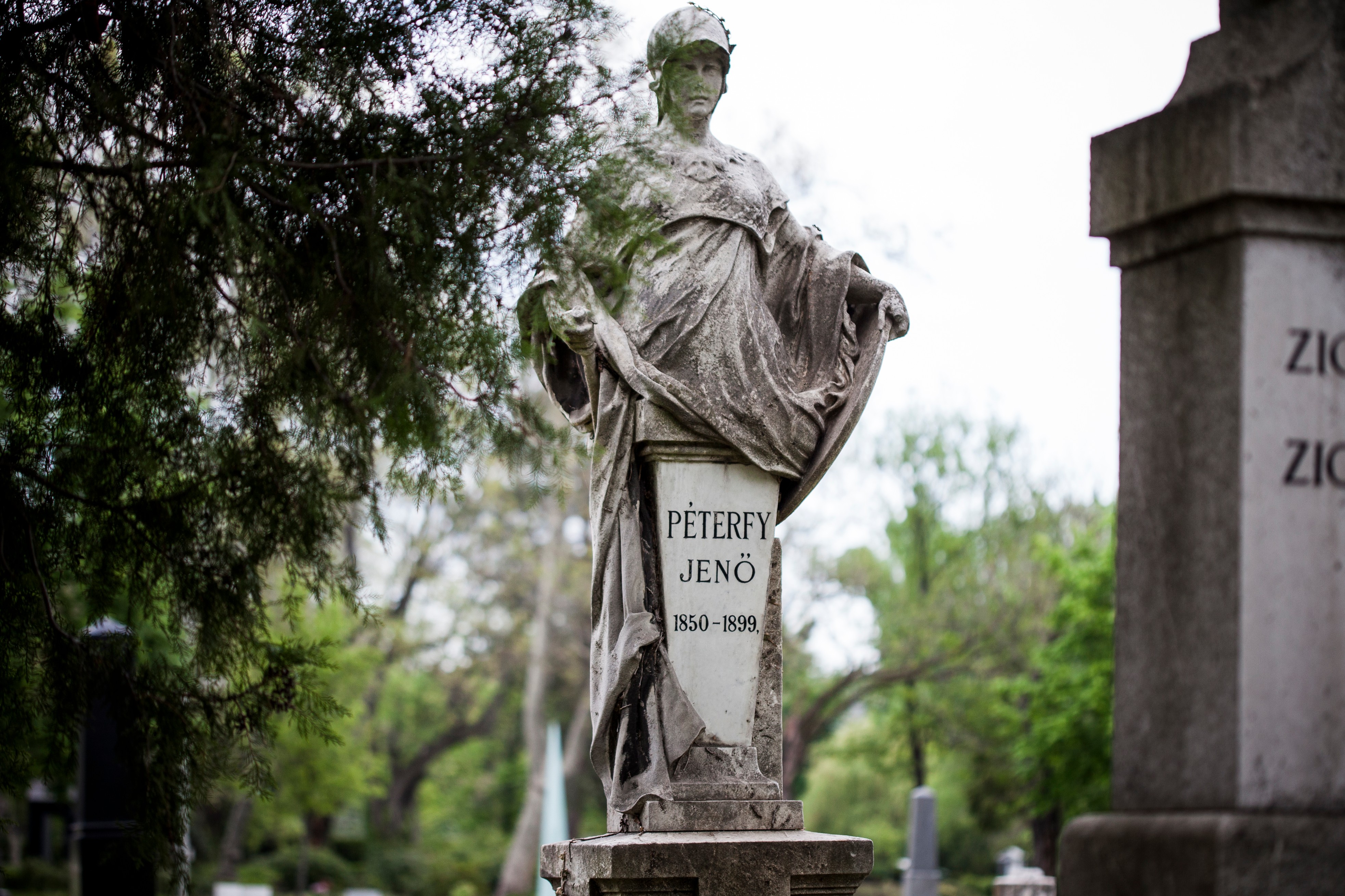
Donáth Gyula a szobor mintáját eredetileg Pulszky Ferenc sírjára tervezte, de felállításáról, későbbi sorsáról nincsenek ismereteink. A Pulszky sírjára tervezett szobrot a korabeli lapok Minerva-szoborként említik. Ennek a szobornak másodpéldányát, Pallasz Athéné elnevezéssel állították fel Péterfy Jenő síremlékeként.
Pallasz Athéné egyik attribútuma a pajzs, amelyet apjától, Zeusztól kapott, és az egyik gorgó, Medusza feje díszítette. A gorgók (Eurüalé, Sztheinó és Medusza) eredetileg gyönyörű leányok voltak, de megsértették Pallasz Athénét, aki bosszúból olyan rúttá változtatta őket, hogy aki rájuk nézett, rögtön kővé dermedt. Az igazság és a művészetek istennője gyakran használta arra Medusza fejével díszített pajzsát, hogy ellenségeit kővé változtassa. Donáth az allegorikus főalakjain a hagyományos és az általa kitalált egyedi szimbolikát ötvözte, aminek ékes példája Péterfy arcképe Pallasz Athéné pajzsán.
A síremlék hátulján a következő felirat: „Fényes szellemed által nemzeted közelébe jutott az emberiség legnagyobbjainak.”
Zichy Jenő síremléke, márvány és bronz, 1909 (28-díszsor-15)
Szobrász: Kozma Erzsébet
Építész: Möller István (1860–1934)
A sírkompozíció ravatalszerűen áll a sírhant fölött, oldaldíszítménye a Szent Apollinare templomban őrzött ókeresztény Teodor püspök sírkövét idézi. A domborművek keresztény szimbólumokat ábrázolnak: Krisztus-monogramot, vagyis a Krisztus nevének görög kezdőbetűiből (khi, ró) kialakított jelet, a bőséget, a jólétet, az áldást jelképező szőlőfürtöt és a halhatatlanság madarait, a pávákat.
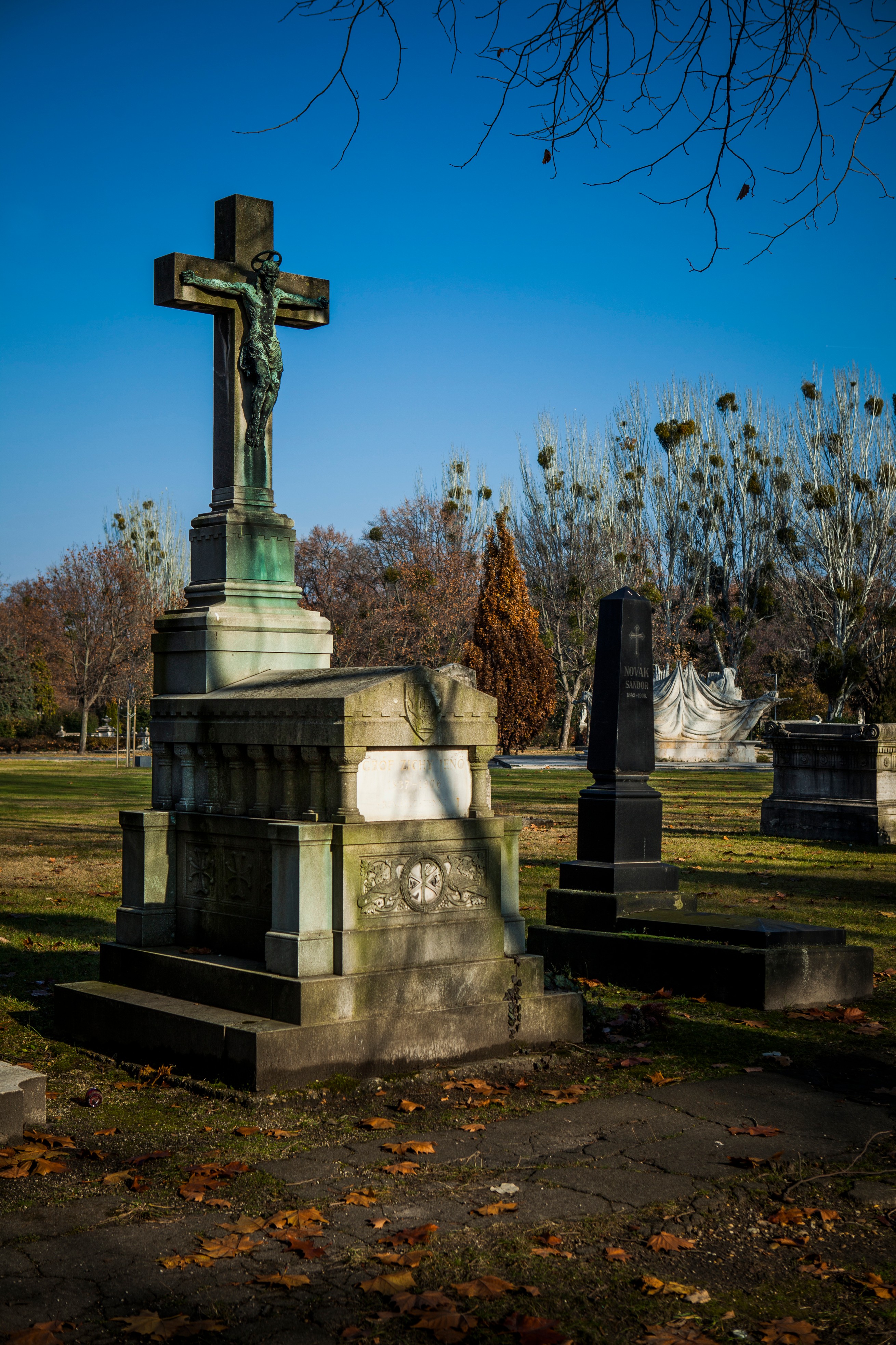
A díszes kőszarkofág kereszt díszítménye illeszkedik az építmény stílusához, a kora középkori korpuszok stílusában készült: Krisztus teste szimmetrikusan rendezve, hosszú tincsekből álló haja a fejtetőn kettéválasztva, karok vízszintesen kinyújtva. A szobrászati elemek Kozma Erzsébet munkái, a sírépítmény terveit Möller István készítette. A neves építész nevéhez fűződik a Vajdahunyadi vár, a Gyulafehérvári Székesegyház, a pécsi Ókeresztény Mauzóleum, a zsámbéki késő korai gótikus templomrom helyreállítása. Csaknem húsz éven át volt a budapesti Műegyetem középkori építész tanszékének tanára.
Fadrusz-kereszt, Fadrusz János síremléke, bronz, alapzat ruskicai márvány (1891) 1926 (28-díszsor-30)
Építész: Hikisch Rezső
Szobrász: Fadrusz János
Fadrusz János a bécsi akadémiai tanulmányai lezárásaként készítette el a megfeszített Krisztus alakját. Fadrusz a munka során hatalmas keresztfát ácsolt, amelyen a szobrot mintázta. Krisztus alakjának elkészítéséhez egy mutatványost kért fel, hogy a fémvázból készült keresztre kötözve legyen modellje a kompozíciónak. A férfi az első alkalom után otthagyta, ezután a művész saját magát kötöztette a keresztre, amiről fényképet készíttetett.
A keresztre feszítés irtózatos fájdalmaitól elgyötört test és arc realisztikus ábrázolása szuggesztív alkotást eredményezett, amellyel az ifjú művész hamar kivívta mind a szakma, mind a közönség elismerését.
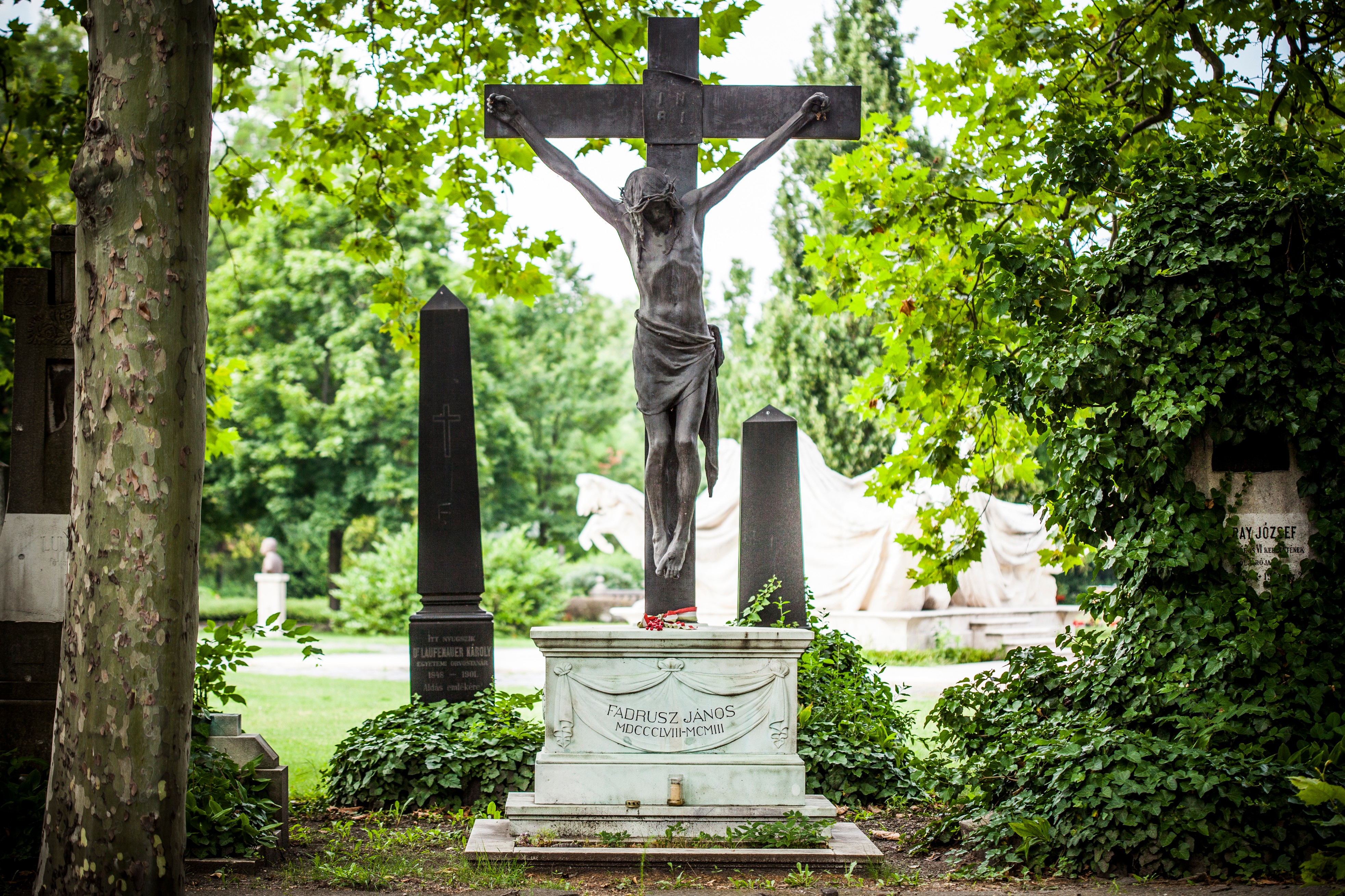 A díjazott alkotásnak több példánya ismert országszerte. A Feszület eredeti gipszmodelljét a művész a pozsonyi Virágvölgyi búcsútemplomnak ajándékozta. Fadruszt a Kolozsváron felállított Mátyás-emlékmű révén szoros érzelmi szálak fűzték a városhoz, ezért a szobrász ajándékaként ide is került egy másodpéldány, amelyet a Szent Mihály templomban állítottak ki. Ugyancsak a művész jóvoltából került a Feszületnek egy példánya a szegedi Fogadalmi templomba is.
A díjazott alkotásnak több példánya ismert országszerte. A Feszület eredeti gipszmodelljét a művész a pozsonyi Virágvölgyi búcsútemplomnak ajándékozta. Fadruszt a Kolozsváron felállított Mátyás-emlékmű révén szoros érzelmi szálak fűzték a városhoz, ezért a szobrász ajándékaként ide is került egy másodpéldány, amelyet a Szent Mihály templomban állítottak ki. Ugyancsak a művész jóvoltából került a Feszületnek egy példánya a szegedi Fogadalmi templomba is.
Az alkotás népszerűségét jelzi, hogy a későbbiekben is még számos helyre készítették el a Feszület másolatait. Fadrusz keresztjével találkozhatunk Pestszentlőrincen, Gödöllőn, Székesfehérváron.
A Feszületnek karok nélküli, torzószerű változata is ismert gipszből, bronzból, márványból elkészítve.
A művész utolsó kívánsága halálos ágyán az volt, hogy sírjára a keresztre feszített Krisztus-műve kerüljön. Ez csak 23 évvel később valósult meg a Főváros támogatásával. A Hikisch Rezső tervezte talapzatra felállították a Feszület bronzból öntött mását. A síremléket 1926-ban mindenszentek napján avatták fel.
A temetőben egy másik síron is fellelhető a Feszület másodpéldánya. Ugyancsak a Fadrusz-kereszt öntött példánya került síremlékül a vasgyáros Heinrich család sírjára.
Klió, Kamermayer Károly síremléke, bronz, 1901 (28-díszsor-36)
Szobrász: Donáth Gyula (1850−1909)
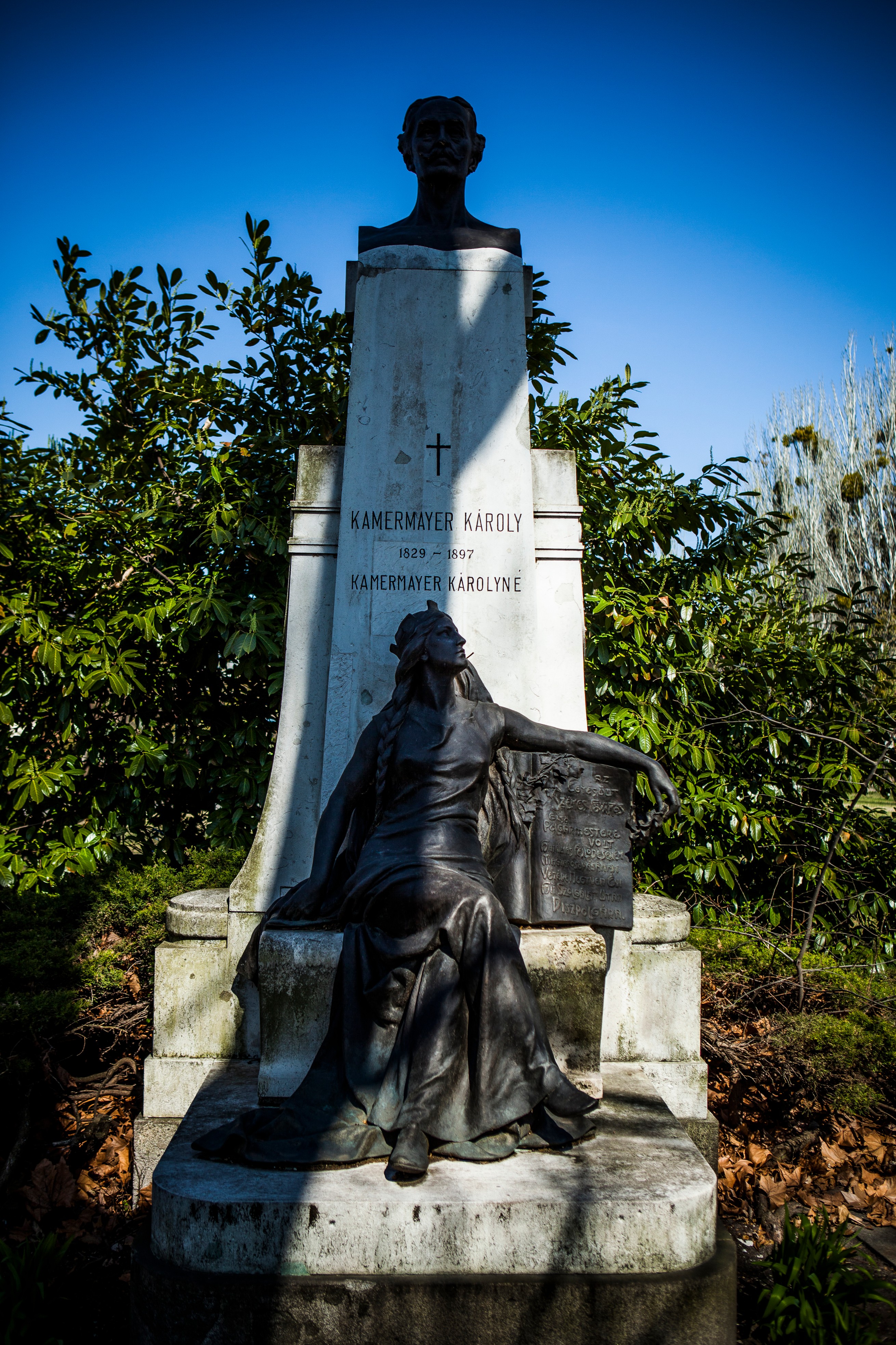 A síremlék tetején látható mellszobor Kamermayer Károlyt, Budapest első polgármesterét ábrázolja. A mellszobor alatt, a márványlap előtt Klió, a történelem múzsája hosszú fonott hajjal, fején koronával ül egy padon. Tekintetét a magasba emeli, a messzeségbe réved. Jobb kezében irónt tart, és egy padon pihenteti, míg bal karját a babérággal díszített feliratos táblán nyugtatja, amelyre az elhunyt érdemeit jegyezte fel örök emlékezetül az utókor számára. „Az egyesület székesfőváros első polgármestere volt. Hatalmas fejlődésének, magyarosodásának vezére, negyven év hű szolgálat után díszpolgára.” A múlt századfordulón a halálhoz való viszonyulás átértelmezése hatással volt a síremlékművészetre is. A portré a halál helyett az életre emlékeztet, a kompozíció szereplői, tárgyai az egykor élt személyre emlékeztetnek, életútjának érdemeire hívják fel a figyelmet.
A síremlék tetején látható mellszobor Kamermayer Károlyt, Budapest első polgármesterét ábrázolja. A mellszobor alatt, a márványlap előtt Klió, a történelem múzsája hosszú fonott hajjal, fején koronával ül egy padon. Tekintetét a magasba emeli, a messzeségbe réved. Jobb kezében irónt tart, és egy padon pihenteti, míg bal karját a babérággal díszített feliratos táblán nyugtatja, amelyre az elhunyt érdemeit jegyezte fel örök emlékezetül az utókor számára. „Az egyesület székesfőváros első polgármestere volt. Hatalmas fejlődésének, magyarosodásának vezére, negyven év hű szolgálat után díszpolgára.” A múlt századfordulón a halálhoz való viszonyulás átértelmezése hatással volt a síremlékművészetre is. A portré a halál helyett az életre emlékeztet, a kompozíció szereplői, tárgyai az egykor élt személyre emlékeztetnek, életútjának érdemeire hívják fel a figyelmet.
A síremlék talapzata és a mellszobor oszlopa márványból, míg Kamermayer büsztje és Klió alakja bronzból készült. A kőfaragói munkát a korszakban sokat foglalkoztatott Senger Béla végezte.
Papp-Váry Elemérné Sziklay Szeréna síremléke, márvány, 1925 (28 díszsor 37)
Szobrász: Horvay János
A Trianoni békeszerződés aláírását követően a Területvédő Liga és a Védő Ligák Szövetsége pályázatot hirdetett egy maximum húsz szavas imára. A bírálóbizottság Papp-Váry Elemérné Sziklay Szeréna költőnő Magyar Hiszekegy című írását hirdette ki győztesnek, aki e néhány sorral beleírta magát a magyar történelembe. A Magyar Hiszekegy bejárta a korabeli magyar sajtót, a korszak „nemzeti imádságává” vált, amit mindenki ismert.
„Hiszek egy Istenben, hiszek egy hazában:
Hiszek egy isteni örök igazságban,
Hiszek Magyarország feltámadásában! Ámen.”
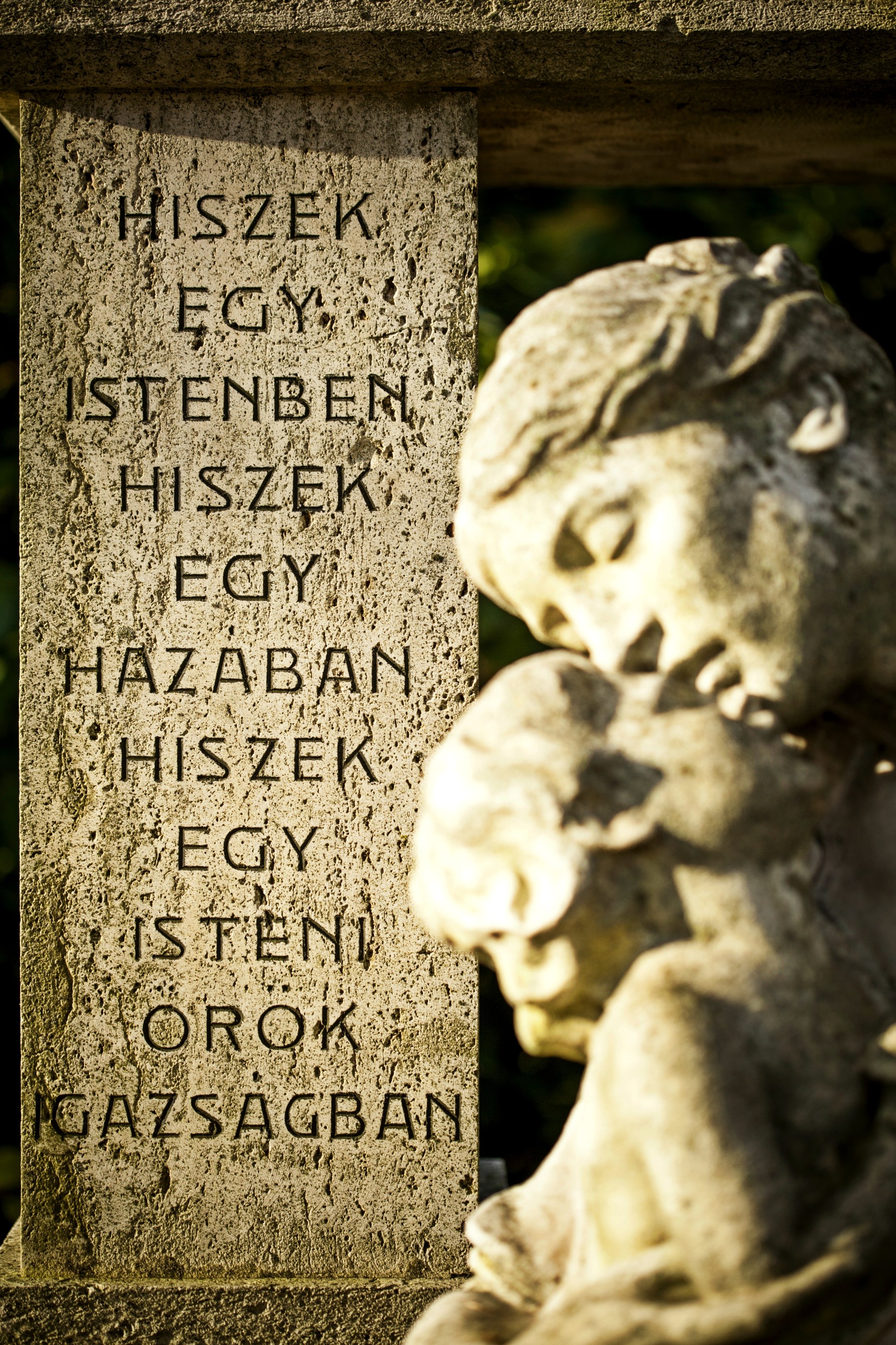
E fohásznak sorait vésték rá az asszony síremlékére is, a szarkofágot tartó oszlopokra. A háromalakos szoborcsoport két gyermeke közt térdelő anyát ábrázol, aki az egyik gyermek fölé hajolva suttogja a Magyar Hiszekegyet, amit a két gyermek imára kulcsolt kézzel az anya utána ismétel. A kompozíciót egy oszlopokra helyezett szarkofág keretezi, melyen a költőnő portré domborműve látható.
A síremléket, amelyet a Magyar Asszonyok Nemzeti Szövetsége készíttetett, a költőnő halála után két évvel, 1925-ben avatták fel nagy tömeg jelenlétében.
Lotz Károly síremléke, bronz, 1930 (28-díszsor-40)
Szobrász: Pásztor János
Az első világháborút követő években számos, évekkel korábban elhunyt nevezetes személynek, közöttük a híres festőnek sem jelölte semmilyen sírjel a nyughelyét. A főváros a külföldi temetők mintáit követve elhatározta, hogy azoknak a kiválóságoknak, akiknek nyughelye jeltelen, igyekeznek művészi síremléket állítani.
Lotz Károly sírszobrának elkészítését Pásztor Jánosra bízták, a bronzszobor avatására 1930-ban került sor. 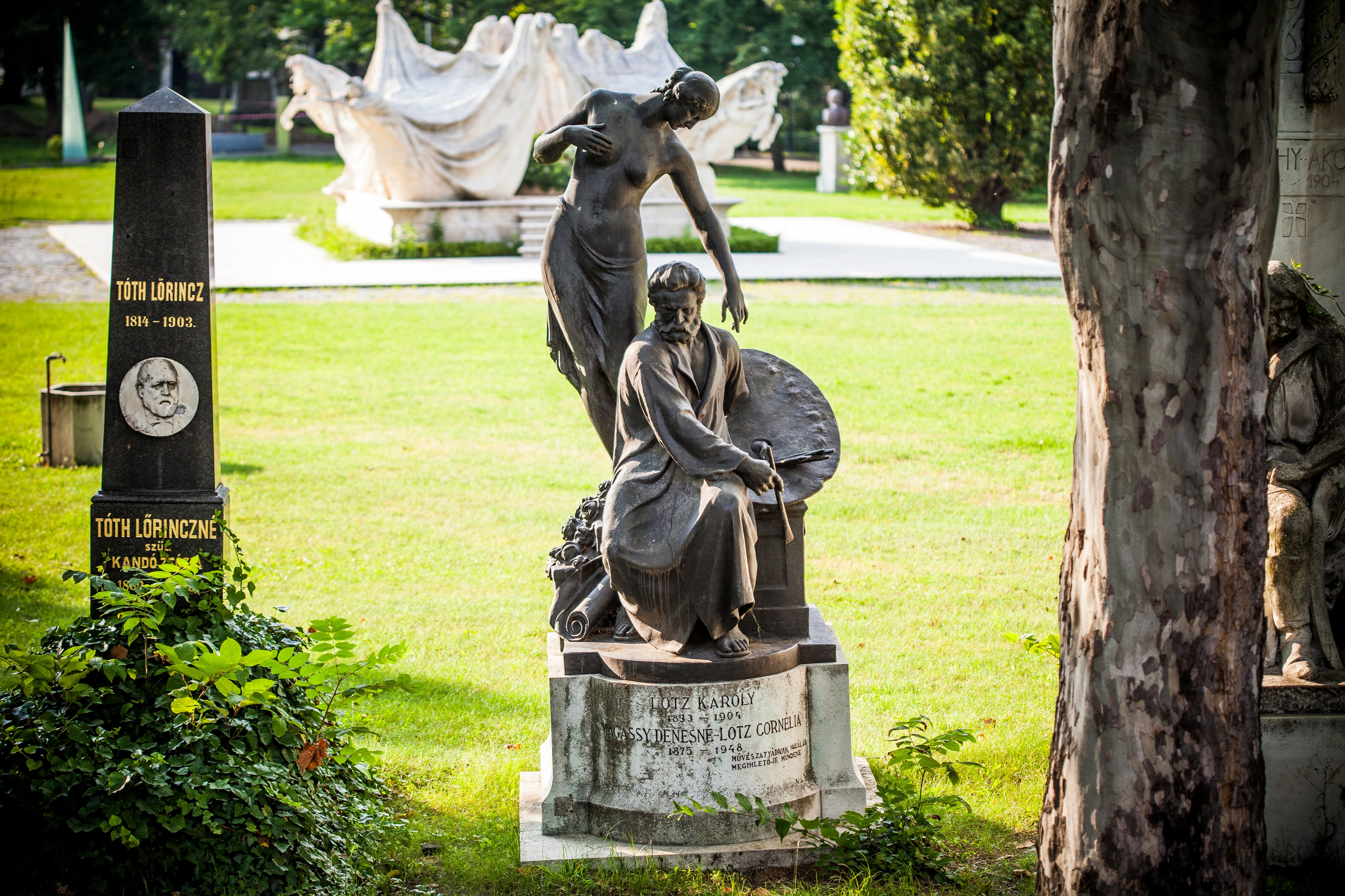
A síremléken maga a festőművész látható munka közben, amint inspirációt gyűjt, egy pillanatra leül, jobb kezét, amelyben az ecsetet fogja, lábán nyugtatja, a baljában palettáját munkára kész állapotban tartja. Ekkor érinti őt meg Múzsája, akinek alakjában Pásztor János a festő nevelt lányát formázta meg. A rajongásig szeretett Kornélia Lotz Károly számos festményének volt modellje és ihletője. Később őt is ide temették el.
A festőművész születésének 100. évfordulójára a Műcsarnok által rendezett kiállítás szoborcsarnokában is bemutatták a különleges szépségű síremlék-kompozíciót.
Beöthy Ákos síremléke, márvány, 1906 (28-díszsor-41)
Szobrász: Zala György
A múlt századforduló első éveinek síremlékművészetében egyfajta szemléletváltozásnak lehetünk tanúi. A sírszobrok immár a halál helyett az életet jelenítik meg az egykor élt személy munkásságának felidézésével, ezáltal az emlékezésre helyezve a hangsúlyt. A síremlékeken megjelenő figura, viselet, tárgy egyben az elhunyt életművének, eszméinek jelképe, így a kompozíciók az elmúlás helyett az örökkévalóság mementói lesznek. Ennek a szemléletnek a jegyében készítette el Zala Beöthy Ákos síremlékét. 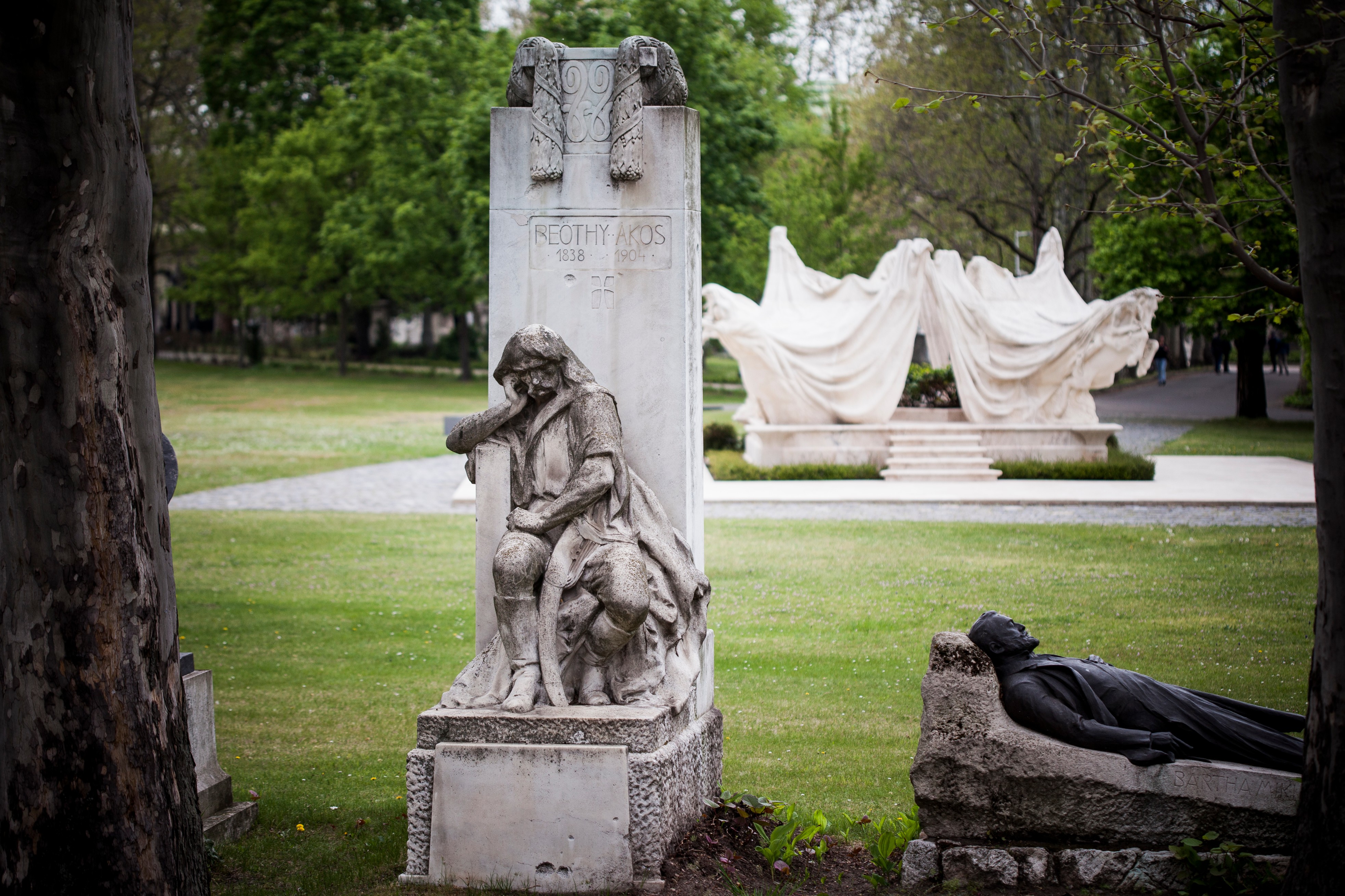
A közismert politikus, publicista emlékobeliszkjének posztamensén egy kuruc vitéz ül szablyával kezében, fejét megtámasztva. A harcos egész testtartása, tekintete a gyász és a szomorúság érzetét kelti, ugyanakkor ez a képi megfogalmazás hűen kifejezi az elhunyt habitusát, életfelfogását. Halálakor kortársai „utolsó kurucként” jellemezték, akinek háború és harc volt az élete, politikai pályafutása.
A magyaros szecessziós motívumokkal díszített oszlop tetején eredetileg a nagyszentmiklósi aranykincs bikafejes ivócsanakjainak kőből faragott másolatai voltak, de ezek ma már sajnos nem láthatóak. Ez a csanak-motívum, amelyet a múlt századfordulót jellemző nemzeti érzület
egyfajta szimbólumaként értelmezünk, egyik igen népszerű, gyakorta alkalmazott díszítménye volt épületeknek, köztéri alkotásoknak, kerámiáknak.
Szilágyi Sándor síremléke bronz, 1900 (28-díszsor 3)
Szobrász: Fadrusz János
Építész: Schickedanz Albert – Herzog Fülöp
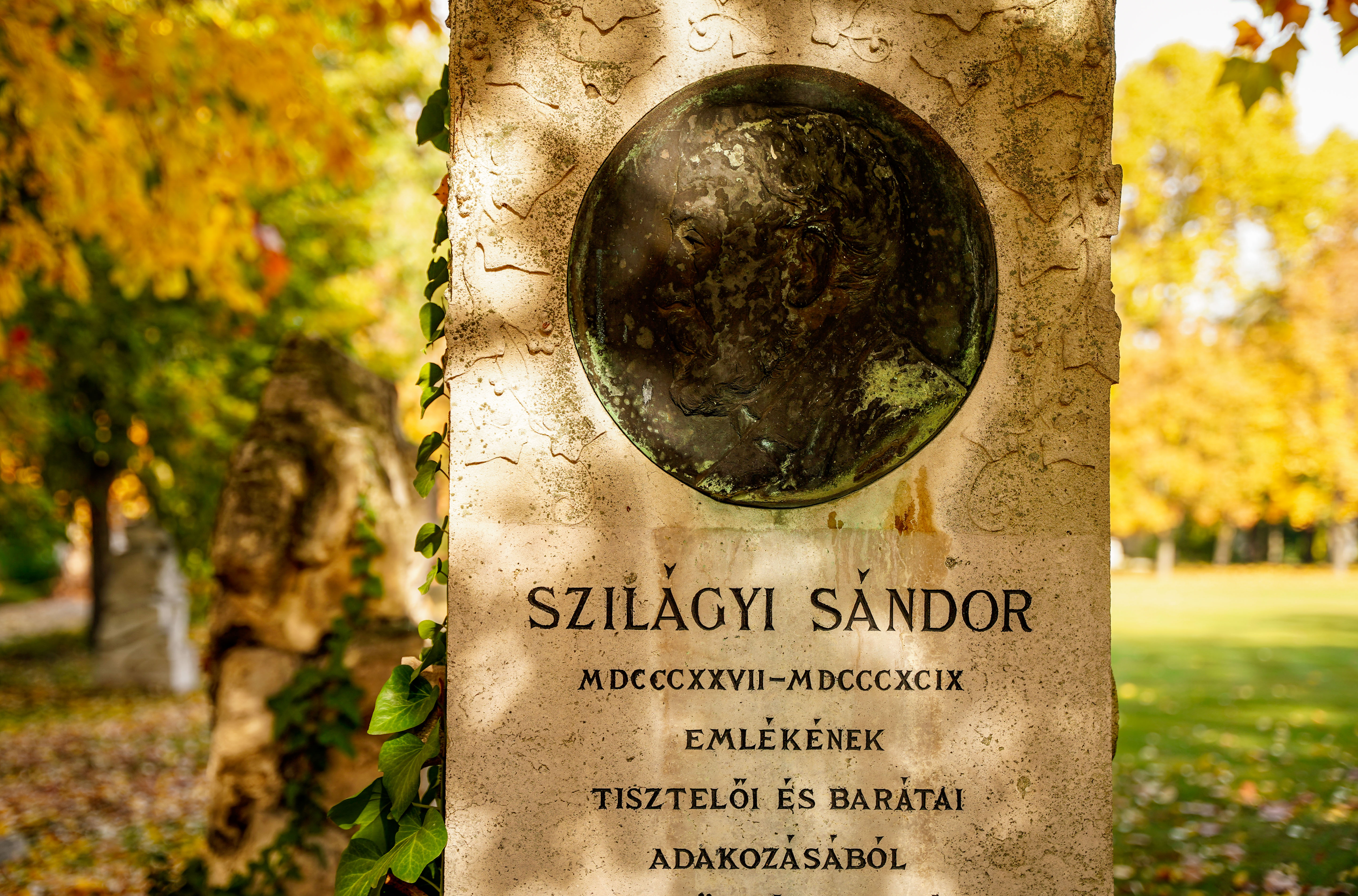 A neves történetíró, Szilágyi Sándor síremlékén a tudóst ábrázoló bronzrelief emlékeztet az elhunytra. Fadrusz ezt a domborművet egy olyan emlékérem alapján mintázta, amelyet Szilágyi Sándor 70. születésnapjára verettek (1897) tisztelői. A jubileumi érmet Scharff Antal, a híres bécsi udvari éremvéső mintázta és a körmöcbányai pénzverő hivatal verte ki. Előlapján Szilágyi Sándor mellképe volt látható, ALEXANDER SZILÁGYI AET. LXX. (Szilágyi Sándor 70 éves korában) körirattal, a hátlap domborműve pedig egy tudóst ábrázolt tanítványai körében, valamint az egyetemi könyvtár épületét, amelynek Szilágyi Sándor az igazgatója volt. A díszes éremből csupán egyetlenegy arany példányt vertek, amit egy ezüst- és egy bronzéremmel bőrtokba helyezve adtak át. Az emlékérem előlapi ábrázolása alapján készült el a síremlék portréképe. A domborművet kiemelik a síremlék dúsan faragott, az öröklétet szimbolizáló borostyánlevél-díszítményei, amelyek mintegy háttérként szolgálnak a portréhoz. A sírkő kompozíciója több hasonlóságot is mutat az építészpáros által korábban tervezett, Semmelweis Ignác számára készített neoreneszánsz stílust idéző síremlékkel: az akrotérion díszítmények, a növényi inda- és levélfaragványok, a díszítő minták variációi mindkét sírnak díszítő elemei. A síremléket 1901 májusában avatták fel ünnepélyes keretek közt.
A neves történetíró, Szilágyi Sándor síremlékén a tudóst ábrázoló bronzrelief emlékeztet az elhunytra. Fadrusz ezt a domborművet egy olyan emlékérem alapján mintázta, amelyet Szilágyi Sándor 70. születésnapjára verettek (1897) tisztelői. A jubileumi érmet Scharff Antal, a híres bécsi udvari éremvéső mintázta és a körmöcbányai pénzverő hivatal verte ki. Előlapján Szilágyi Sándor mellképe volt látható, ALEXANDER SZILÁGYI AET. LXX. (Szilágyi Sándor 70 éves korában) körirattal, a hátlap domborműve pedig egy tudóst ábrázolt tanítványai körében, valamint az egyetemi könyvtár épületét, amelynek Szilágyi Sándor az igazgatója volt. A díszes éremből csupán egyetlenegy arany példányt vertek, amit egy ezüst- és egy bronzéremmel bőrtokba helyezve adtak át. Az emlékérem előlapi ábrázolása alapján készült el a síremlék portréképe. A domborművet kiemelik a síremlék dúsan faragott, az öröklétet szimbolizáló borostyánlevél-díszítményei, amelyek mintegy háttérként szolgálnak a portréhoz. A sírkő kompozíciója több hasonlóságot is mutat az építészpáros által korábban tervezett, Semmelweis Ignác számára készített neoreneszánsz stílust idéző síremlékkel: az akrotérion díszítmények, a növényi inda- és levélfaragványok, a díszítő minták variációi mindkét sírnak díszítő elemei. A síremléket 1901 májusában avatták fel ünnepélyes keretek közt.
A kolozsvári „Mátyás király” és a „Krisztus a kereszten” című szobrok alkotóját, a 19. századi magyar történeti szobrászat egyik legnagyobb alakját, Fadrusz Jánost korai halála megakadályozta abban, hogy megannyi dédelgetett szoborterve megvalósuljon és közkinccsé váljon az utókor számára. A művész kisszámú köztéri alkotásai között Szilágyi Sándor sírjának bronzreliefje emiatt is különösen értékes darab a Fiumei úti sírkert szobrászati emlékanyagában.
Panaszos dal, Teleszky István síremléke, bronz, 1897 28-díszsor-6
Szobrász: Donáth Gyula
 A síremléken látható nőalak figuráját Donáth Gyula szobrászművész eredetileg az Irányi Dániel síremlékére kiírt pályázatra nyújtotta be, azonban az 1901-ben felállított Irányi-síremlék Kallós Ede, Bálint Zoltán és Jámbor Lajos alkotásaként született meg. A Donáth által tervezett Panaszos dal allegorikus női figuráját pár évvel később a magyar örökösödési törvény kidolgozójának síremlékére állították fel. A korszak egyik legnépszerűbb funerális művészének tartott alkotó sírszobrainak többségében női alakot formázott, aki vagy mitológiai alakot öltöttek, vagy az elmúlás, a gyász allegóriájaként szerepeltek. Ez utóbbira példa Teleszky István síremlékének figurája is, mint ahogy az alkotás címe is sugallja. A szobor egy éneklő alakot ábrázol, kinek szomorú éneke az elhunyt iránti gyászt fejezi ki. A kontraposztba állított, lepelbe burkolt, tekintetét az ég felé fordító, távolba révedő nő összekulcsolt kezei közt az örökkévalóság szimbólumaként rózsát tart. A síremlékszobor kisebb, 70 cm magas változatát a Magyar Nemzeti Galéria 19–20. századi szoborgyűjteménye őrzi.
A síremléken látható nőalak figuráját Donáth Gyula szobrászművész eredetileg az Irányi Dániel síremlékére kiírt pályázatra nyújtotta be, azonban az 1901-ben felállított Irányi-síremlék Kallós Ede, Bálint Zoltán és Jámbor Lajos alkotásaként született meg. A Donáth által tervezett Panaszos dal allegorikus női figuráját pár évvel később a magyar örökösödési törvény kidolgozójának síremlékére állították fel. A korszak egyik legnépszerűbb funerális művészének tartott alkotó sírszobrainak többségében női alakot formázott, aki vagy mitológiai alakot öltöttek, vagy az elmúlás, a gyász allegóriájaként szerepeltek. Ez utóbbira példa Teleszky István síremlékének figurája is, mint ahogy az alkotás címe is sugallja. A szobor egy éneklő alakot ábrázol, kinek szomorú éneke az elhunyt iránti gyászt fejezi ki. A kontraposztba állított, lepelbe burkolt, tekintetét az ég felé fordító, távolba révedő nő összekulcsolt kezei közt az örökkévalóság szimbólumaként rózsát tart. A síremlékszobor kisebb, 70 cm magas változatát a Magyar Nemzeti Galéria 19–20. századi szoborgyűjteménye őrzi.
A művészi síremléket 1903 őszén leplezték le ünnepélyes keretek közt.
Erkel Sándor (1846–1900) A magyar zene, 1905, bronz 28-díszsor-9
Szobrász: Róna József
Építész: Márkus Géza
 Erkel Ferenc és fia, Sándor nyughelyének méltó emlékkel való megjelölését maga a miniszterelnök, Széll Kálmán kezdeményezte 1903 legelején az Operaház vezetőségénél. Mindkét síremlék építészeti elemeinek tervezésére a magyarországi szecesszió egyik jelentős építészét, Márkus Gézát kérték fel. Erkel Sándor síremlékének egyedi formája és díszítése különleges példája a temető szecessziós síremlékművészetének. A sírt egy stilizált húros hangszer, az ókori görögök által használt líra formájában végződő márványobeliszk jelöli, amelynek két oldalát alul az énekéről híres, Apollónak szentelt madarat, a hattyút ábrázoló dombormű díszíti. A síremlékre a magyar zene allegóriájának szobra került, egy magyaros gyászruhába burkolt, hegedűn játszó nő, aki örök muzsikájával emlékeztet az elhunyt halhatatlanságára. A bronz főalak arcvonásaiban Róna József szobrászművész a felesége unokahúgát, a legendásan szép és sokoldalú Vészi Margitot örökítette meg. Az emlék talapzatán az egykori főzeneigazgató, Erkel Sándor arcképének domborműve látható, rajta a karmesteri jelvényekkel, partitúrával és a vezénylő pálcával.
Erkel Ferenc és fia, Sándor nyughelyének méltó emlékkel való megjelölését maga a miniszterelnök, Széll Kálmán kezdeményezte 1903 legelején az Operaház vezetőségénél. Mindkét síremlék építészeti elemeinek tervezésére a magyarországi szecesszió egyik jelentős építészét, Márkus Gézát kérték fel. Erkel Sándor síremlékének egyedi formája és díszítése különleges példája a temető szecessziós síremlékművészetének. A sírt egy stilizált húros hangszer, az ókori görögök által használt líra formájában végződő márványobeliszk jelöli, amelynek két oldalát alul az énekéről híres, Apollónak szentelt madarat, a hattyút ábrázoló dombormű díszíti. A síremlékre a magyar zene allegóriájának szobra került, egy magyaros gyászruhába burkolt, hegedűn játszó nő, aki örök muzsikájával emlékeztet az elhunyt halhatatlanságára. A bronz főalak arcvonásaiban Róna József szobrászművész a felesége unokahúgát, a legendásan szép és sokoldalú Vészi Margitot örökítette meg. Az emlék talapzatán az egykori főzeneigazgató, Erkel Sándor arcképének domborműve látható, rajta a karmesteri jelvényekkel, partitúrával és a vezénylő pálcával.
Az emlék felavatására az 1905. év mindenszentek előtti napján került sor, ünnepélyes keretek közt.
Érdekesség, hogy a hegedülő női bronzszobornak van egy másodpéldánya is, ami a soproni Szent Mihály temetőben az 1910-ben elhunyt nemzetközi hírű cigányprímás, Munczy Lajos sírját díszíti.
Zichy Mihály síremléke, ruskicai márvány, 1916 28 díszsor-14
Szobrász: Stróbl Alajos
Építész: Gerster Kálmán
 A több cár szolgálatában is álló festőfejedelem a hazájától távol, Oroszországban hunyt el, s hogy magyar földben nyugodhasson, hazaszállították holttestét. Munkácsyhoz hasonlóan őt is a Műcsarnokban ravatalozták fel, temetését nagy gyászpompa kísérte. Síremlékének felállítására 10 évvel később került sor. Sírszobrának elkészítésére a család Stróbl Alajost kérte fel, aki korának legtöbbet foglalkoztatott szobrásza volt, és a hazai portrészobrászat egyik legnagyobb alakjának tartottak. Temetői alkotásainak többségénél jellemző az arcképábrázolás, mint például Kelety Gusztáv, Szilágyi Dezső, Eötvös Loránd, Ybl Miklós síremlékén, de saját sírján is, ahova ifjú önarcképének másolatát helyezték. Zichy Mihály sírjára is az elhunyt portréját formázta meg Stróbl, a művész alkotó munkáinak kellékeivel, kezében rajzalbumával és rajzeszközével. A munka közben ábrázolt festő-grafikus alakja nem az elmúlást idézi meg, hanem művészetének halhatatlanságát. A síremlék építészeti terveit Gerster Kálmán készítette – a temető több más funerális emléke is közös munkájuk Stróbl Alajos szobrászművésszel (Kossuth-mauzóleum, Henneberg Károly és Arany János síremléke). A síremléken látható Zichy-portrészobor másodpéldánya a Szegednek adományozott szobrok egyikeként látható a Dóm tér árkádjai alatt, a Nemzeti Emlékcsarnok részeként.
A több cár szolgálatában is álló festőfejedelem a hazájától távol, Oroszországban hunyt el, s hogy magyar földben nyugodhasson, hazaszállították holttestét. Munkácsyhoz hasonlóan őt is a Műcsarnokban ravatalozták fel, temetését nagy gyászpompa kísérte. Síremlékének felállítására 10 évvel később került sor. Sírszobrának elkészítésére a család Stróbl Alajost kérte fel, aki korának legtöbbet foglalkoztatott szobrásza volt, és a hazai portrészobrászat egyik legnagyobb alakjának tartottak. Temetői alkotásainak többségénél jellemző az arcképábrázolás, mint például Kelety Gusztáv, Szilágyi Dezső, Eötvös Loránd, Ybl Miklós síremlékén, de saját sírján is, ahova ifjú önarcképének másolatát helyezték. Zichy Mihály sírjára is az elhunyt portréját formázta meg Stróbl, a művész alkotó munkáinak kellékeivel, kezében rajzalbumával és rajzeszközével. A munka közben ábrázolt festő-grafikus alakja nem az elmúlást idézi meg, hanem művészetének halhatatlanságát. A síremlék építészeti terveit Gerster Kálmán készítette – a temető több más funerális emléke is közös munkájuk Stróbl Alajos szobrászművésszel (Kossuth-mauzóleum, Henneberg Károly és Arany János síremléke). A síremléken látható Zichy-portrészobor másodpéldánya a Szegednek adományozott szobrok egyikeként látható a Dóm tér árkádjai alatt, a Nemzeti Emlékcsarnok részeként.
Horánszky Nándor sírja, A feltámadás angyala, 1904, márvány 28-díszsor-38
Szobrász: Gerenday Béla
Eredeti mű: Giulio Monteverde: L'Angelo della Resurrezione (Feltámadás angyala), 1882
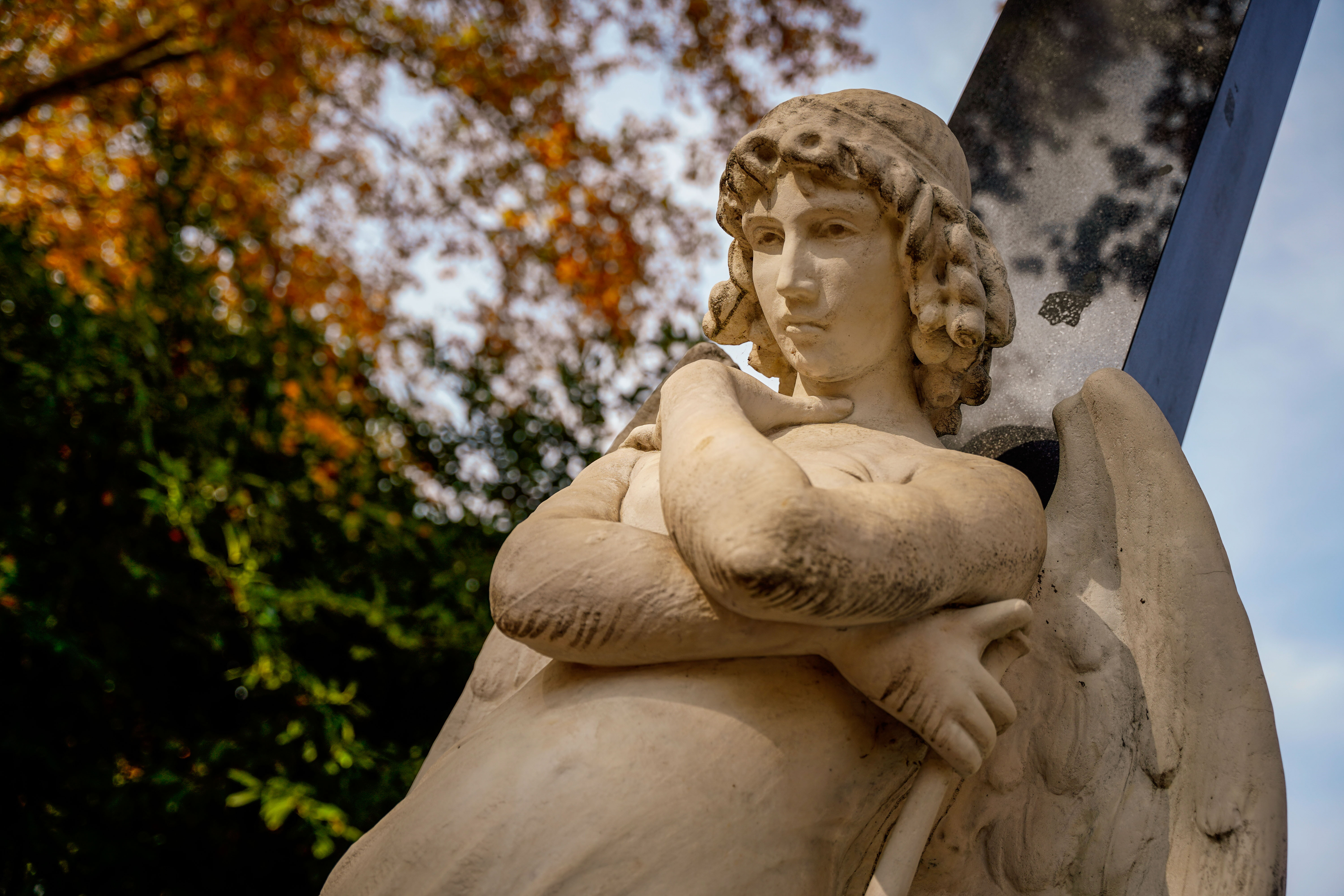 A temetőben több olyan síremlék is található, amelyek népszerűvé vált alkotások másolataként készültek megrendelésre. Ezek egyike a Horánszky Nándor síremlékén álló angyalszobor, amely a genovai Staglieno temetőben nyugvó Oreno család síremlékének figurális alakja alapján készült. Az eredeti síremlék, amit a klasszicista vallási szobrászat egyik remekművének tartanak, a „Feltámadás angyala” címet viseli, de alkotójáról egyszerűen „Monteverde-angyalnak” is szokták nevezni. Giulio Monteverde olasz szobrász angyalszobrai közül ez az egyik, ami a funerális művészet legtöbbet reprodukált alkotásává vált. A Feltámadás angyalát Francesco Oneto bankelnök rendelte meg családtagjának síremlékéül a mestertől 1882-ben. Magának a szobrászművésznek a Rómában található sírját is ez a saját alkotása, a Feltámadás angyala jelöli. A jobb kezében harsonát tartó angyal maga elé meredve, kitartóan várakozik, amit testtartása, keresztbe rakott lábai fejeznek ki. Felkészül, hogy megfújja a harsonáját. A kompozíció utalás a Jelenések könyvének hét harsonát tartó angyalaira, akik Isten ítéletének jeleként fújják meg azokat. Monteverde angyala a hetedik harsonát készül megfújni, amely az ítélet és az üdvösség beteljesedését, az emberiség végső sorsát hirdeti. A néhai miniszter sírján szereplő Monteverde-angyal másolat fekete gránit kereszt előtt áll, arcvonásaiban és részleteiben csupán kisebb eltérések tapasztalhatóak az eredeti alkotáshoz képest.
A temetőben több olyan síremlék is található, amelyek népszerűvé vált alkotások másolataként készültek megrendelésre. Ezek egyike a Horánszky Nándor síremlékén álló angyalszobor, amely a genovai Staglieno temetőben nyugvó Oreno család síremlékének figurális alakja alapján készült. Az eredeti síremlék, amit a klasszicista vallási szobrászat egyik remekművének tartanak, a „Feltámadás angyala” címet viseli, de alkotójáról egyszerűen „Monteverde-angyalnak” is szokták nevezni. Giulio Monteverde olasz szobrász angyalszobrai közül ez az egyik, ami a funerális művészet legtöbbet reprodukált alkotásává vált. A Feltámadás angyalát Francesco Oneto bankelnök rendelte meg családtagjának síremlékéül a mestertől 1882-ben. Magának a szobrászművésznek a Rómában található sírját is ez a saját alkotása, a Feltámadás angyala jelöli. A jobb kezében harsonát tartó angyal maga elé meredve, kitartóan várakozik, amit testtartása, keresztbe rakott lábai fejeznek ki. Felkészül, hogy megfújja a harsonáját. A kompozíció utalás a Jelenések könyvének hét harsonát tartó angyalaira, akik Isten ítéletének jeleként fújják meg azokat. Monteverde angyala a hetedik harsonát készül megfújni, amely az ítélet és az üdvösség beteljesedését, az emberiség végső sorsát hirdeti. A néhai miniszter sírján szereplő Monteverde-angyal másolat fekete gránit kereszt előtt áll, arcvonásaiban és részleteiben csupán kisebb eltérések tapasztalhatóak az eredeti alkotáshoz képest.
Tomb of Károly Csemegi, marble (Carrara), 1902 (28-honorary row-1)
Sculptor: Gyula Donáth (1850−1909)
The principal figure on the tomb of Károly Csemegi is Justitia, goddess of justice, who with her left hand touches the brow of Csemegi while in her right she bears a sword and flaming torch illuminating an inscription in the upper part of the sculpture.
 The numbers ‘1878. V.’ refer to Act V. of 1878, which proclaimed the first criminal code in Hungarian, commonly known as the Csemegi codex. Thus it is evident why Donáth’s statue of the Roman goddess of justice is on the grave of the judge. We regularly come across figures from the mythology of Antiquity in the funerary art of Gyula Donáth: Atropos, one of the Moirai, on the grave of Adolf Huszár, Clio, muse of history, on the tomb of Károly Kamermayer, and Minerva on that of Jenő Péterfy.
The numbers ‘1878. V.’ refer to Act V. of 1878, which proclaimed the first criminal code in Hungarian, commonly known as the Csemegi codex. Thus it is evident why Donáth’s statue of the Roman goddess of justice is on the grave of the judge. We regularly come across figures from the mythology of Antiquity in the funerary art of Gyula Donáth: Atropos, one of the Moirai, on the grave of Adolf Huszár, Clio, muse of history, on the tomb of Károly Kamermayer, and Minerva on that of Jenő Péterfy.
As a mark of his respect for Károly Csemegi, Gyula Donáth made the statue at no cost to the family.
Tomb of Jenő Péterfy, marble, 1901 (28-1/a-15)
Sculptor: Gyula Donáth (1850−1909)
In 1901, Gyula Donáth worked on several tombs in parallel. One was for the mayor of Budapest Károly Kamermayer, another for the teacher and art historian Jenő Péterfy. The two tombs were inaugurated just a few days apart. In the final decade of the life of Jenő Péterfy, he immersed himself in the study of the Greek language and history of Greek literature. His tomb depicts his last great love, one of the iconic figures of Greek mythology, Pallas Athena. The goddess has a helmet on her head, a breastplate, a torch in her right hand and in her left a shield bearing a portrait of Péterfy.
 Gyula Donáth originally planned the design of the statue for the grave of Ferenc Pulszky but we have no knowledge of its installation and later fate. Newspapers of the day refer to the statue planned for the Pulszky grave as the Minerva statue. A copy of this statue with the name Pallas Athena was erected as the tomb for Jenő Péterfy.
Gyula Donáth originally planned the design of the statue for the grave of Ferenc Pulszky but we have no knowledge of its installation and later fate. Newspapers of the day refer to the statue planned for the Pulszky grave as the Minerva statue. A copy of this statue with the name Pallas Athena was erected as the tomb for Jenő Péterfy.
One of the attributes of Pallas Athena is her shield, which she received from her father Zeus. It was embellished with the head of one of the Gorgons, Medusa. Originally, the Gorgons (Euryale, Stheno and Medusa) were beautiful girls but they insulted Pallas Athene, who in revenge transformed them into such hideous creatures that whoever looked on them was immediately turned to stone. The goddess of justice and arts frequently used her shield decorated with the head of Medusa to transform her enemies into stone. Donáth combined traditional and his own unique symbolism on his allegorical principal figures, one remarkable example of which is the Péterfy portrait on the shield of Pallas Athena.
On the reverse of the tomb is the following inscription: ‘Through your bright spirit, your nation came close to humanity’s greatest.’
Tomb of Jenő Zichy, marble and bronze, 1909 (28-honorary row-15)
Sculptor: Erzsébet Kozma
Architect: István Möller (1860–1934)
The funerary composition stands above the grave in the manner of a bier. The side ornamentation evokes the gravestone of early Christian bishop Theodore preserved in the Church of San Apollinare. 
The reliefs depict Christian symbols: the Christogram, that is, the symbol made up of the initial letters of Christ in Greek (Chi-Rho), the grapevine symbolizing bounty, welfare and blessing, and peacocks, birds of immortality. The cross ornamentation of the ornate stone sarcophagus matches the style of the structure made in the style of early medieval corpora: the body of Christ is set symmetrically, his long hair is parted on the crown of the head and his arms are stretched horizontally. The sculptural elements are the work of Erzsébet Kozma, István Möller drafted the plans for the tomb. The famous architect is also associated with Vajdahunyad Castle, Alba Iulia Cathedral, the Early Christian Mausoleum in Pécs, and the Zsámbék early Gothic church ruins reconstruction. He was a teacher at the medieval architecture department of Budapest Technical University for nearly 20 years.
Fadrusz cross, tomb of János Fadrusz, bronze, pedestal of Rușchița marble (1891) 1926 (28-honorary row-30)
Architect: Rezső Hikisch
Sculptor: János Fadrusz
János Fadrusz made the figure of Christ crucified at the end of his studies at the Viennese academy. While working on the piece, Fadrusz built a huge cross from wood, on which he modelled the work. To make the figure of Christ, he asked a circus performer to be his model for the composition. The man was tied to a cross made from a metal framework. After the first session he quit, on which the artist had himself bound to the cross and then photographed.
A realistic depiction of body and face tormented by the terrible pains of crucifixion resulted in an expressive work, which soon won the young artist a considerable reputation both among the general public and the profession. 
Several examples of the prize-winning work are located across Hungary. The artist donated the original plaster model of Crucifixion to the Blumental Church, Bratislava. Fadrusz developed close ties with Cluj-Napoca through the Matthias memorial erected in the city, which is why another copy of the work gifted by the sculptor was erected here, in the Church of St. Michael. Through the offices of the artist, yet another replica of Crucifixion is to be found in the Votive Church in Szeged.
An indication of the popularity of the artwork is that later on copies of Crucifixion were made for many other places. We can find the Fadrusz cross in Pestszentlőrinc, Gödöllő and Székesfehérvár.
A torso version of Crucifixion was made in plaster, bronze and marble.
The dying wish of the artist was that his Christ on the cross work should be erected on his grave. This took 23 years to arrange with the backing of the Municipality. A copy of Crucifixion cast in bronze was erected on the pedestal designed by Rezső Hikisch. The tomb was inaugurated on All Saints Day, 1926.
The cemetery has another copy of Crucifixion on another grave: a cast of the Fadrusz cross found its way to the family tomb of the ironworks owner Heinrich.
Clio, tomb of Károly Kamermayer, bronze, 1901 (28-honorary row-36)
Sculptor: Gyula Donáth (1850−1909)
The bust at the top of the tomb is that of Károly Kamermayer, Budapest’s first mayor. Under the bust, in front of the marble façade, is Clio, the muse of history, with long braided hair, seated on a bench with a crown on her head. Her eyes are raised upwards, gazing into the distance. 
She holds a stylus in her right hand while her left arm rests on a tablet with inscription ornamented with laurels, on which the achievements of the deceased have been written for posterity. “He was the first mayor of the united royal municipality. The overseer of its enormous development and Hungarianization, freeman of the city after forty years of faithful service.” At the turn of the last century, a reinterpretation of attitudes toward death also had an impact on funerary art. Instead of death, the portrait reminds us of life, the characters and objects of the composition recall the person who once lived and draw attention to the merits of their life.
The tomb pedestal and column supporting the bust are of marble while the bust of Kamermayer and the figure of Clio are cast in bronze. The stone carving was carried out by Béla Senger, an artist much in demand at the time.
Tomb of Papp-Váry Elemérné, Szeréna Sziklay, marble, 1925 (28-honorary row-37)
Sculptor: János Horvay
 Following the signing of the peace treaty of Trianon, the League of Defenders of the Country and the Association of Protector Leagues announced a tender for a maximum 20-word prayer. The jury commission announced Hungarian Creed by poetess Papp-Váry Elemérné, Szeréna Sziklay the winner, who with these few lines wrote herself into Hungarian history. Hungarian Creed was publicized in the Hungarian press and it became the ‘national prayer’ known by all.
Following the signing of the peace treaty of Trianon, the League of Defenders of the Country and the Association of Protector Leagues announced a tender for a maximum 20-word prayer. The jury commission announced Hungarian Creed by poetess Papp-Váry Elemérné, Szeréna Sziklay the winner, who with these few lines wrote herself into Hungarian history. Hungarian Creed was publicized in the Hungarian press and it became the ‘national prayer’ known by all.
“I believe in God, I believe in my country:
I believe in an eternal divine justice,
I believe in the resurrection of Hungary! Amen.”
The lines of this supplication were inscribed on the tomb of the poetess, on the columns supporting the sarcophagus. The composition comprising three figures shows a kneeling mother between her two children. Bending over one of the children, she is whispering the Hungarian Creed, which the two children are repeating after the mother with hands clasped in prayer. The composition is framed by a sarcophagus located on columns, on which there is the portrait in relief of the poetess.
The tomb, which was commissioned by the National Association of Hungarian Women, was inaugurated in 1925, two years after the poetess died, in the presence of a huge crowd.
Tomb of Károly Lotz, bronze, 1930 (28-honorary row-40)
Sculptor: János Pásztor
In the years following the First World War, many resting places, including that of the famous painter who died years earlier, were left totally unmarked. Copying the practice of cemeteries abroad, the municipality decided to set up artistic tombs for those prominent personages whose resting places were left unmarked.
János Pásztor was commissioned to make the funerary statue for Károly Lotz. The bronze statue was unveiled in 1930. 
The tomb portrays the painter himself in the midst of working, as he gathers inspiration, sitting for a moment, resting his right hand, in which he holds a brush, on his leg, in his left he holds the palette ready for work. At this moment he is touched by his Muse; for this figure, János Pásztor modelled the daughter of the painter. His beloved Kornélia was the model and inspiration for numerous paintings by Károly Lotz. Later, she too was buried here.
This remarkably beautiful composition was also shown in the hall of statues of an exhibition organized by Műcsarnok on the 100th anniversary of the birth of the painter.
Tomb of Ákos Beöthy, marble, 1906 (28-honorary row-41)
Sculptor: György Zala
The early years of the last century were witness to a shift of attitude in funerary art. Instead of death, funerary statues represent life by recalling the achievements of the deceased, thereby placing the emphasis on remembrance. The figure, dress and objects appearing on the tombs are at the same time symbols of the oeuvre and creed of the deceased, so compositions are more about mementoes of eternity than passing. Zala made Ákos Beöthy’s tomb in this spirit. 
An insurgent kuruc knight sits with sabre in hand, leaning his head on his arm, on the pedestal of the memorial obelisk to the well-known politician and publicist. The entire body language and gaze of the warrior speak of mourning and grief, yet at the same time the pictorial image faithfully expresses the habits and mindset of the deceased. On his death, his contemporaries characterized him as the ‘last kuruc’, for whom warring and the fight were his life and political career.
Originally, stone carved copies of the bull’s head drinking cups from the Nagyszentmiklós hoard stood on the top of the column decorated with Hungarian Art Nouveau motifs, but sadly these are no longer there. This bowl motif, which we can interpret as a kind of symbol of national sentiment typical of the previous turn of the century, was a very popular and widespread ornamentation used on buildings, for public works and ceramics.
Grave of Sándor Szilágyi, bronze, 1900 28-díszsor 3
Sculptor: János Fadrusz
Architects: Albert Schickedanz – Fülöp Herzog
 The bronze relief depicting famous historian Sándor Szilágyi commemorates the deceased. János Fadrusz patterned his relief on a medallion that was struck to mark the 70th birthday of Sándor Szilágyi in 1897. The jubilee medallion was designed by Antal Scharff, the famous Viennese court engraver, and struck by the Kremnica (Körmöcbánya) mint. On the observe there was a bust of Sándor Szilágyi with the script ALEXANDER SZILÁGYI AET. LXX. (Sándor Szilágyi at the age of 70) around the edge, and on the reverse, a relief depicted a scholar surrounded by his students, and the university library, of which Sándor Szilágyi was director. Only one gold commemorative medallion was ever struck, which was then presented along with a silver and a bronze medallion in a leather case. The portrait on the grave was made on the basis of the obverse depiction of the medallion. The relief is brought out by the richly carved surrounding profusion of ivy leaf decoration, symbolizing eternity, which serves as a background to the portrait. The gravestone composition shows several similarities with the tomb in Neo-renaissance style designed by the two architects earlier for Ignác Semmelweis: the acroterion ornamentation, the floral shoot and leaf carvings, the variation of decorative patterns are elements to be found on both graves. The monument was unveiled at a formal ceremony in May 1901.
The bronze relief depicting famous historian Sándor Szilágyi commemorates the deceased. János Fadrusz patterned his relief on a medallion that was struck to mark the 70th birthday of Sándor Szilágyi in 1897. The jubilee medallion was designed by Antal Scharff, the famous Viennese court engraver, and struck by the Kremnica (Körmöcbánya) mint. On the observe there was a bust of Sándor Szilágyi with the script ALEXANDER SZILÁGYI AET. LXX. (Sándor Szilágyi at the age of 70) around the edge, and on the reverse, a relief depicted a scholar surrounded by his students, and the university library, of which Sándor Szilágyi was director. Only one gold commemorative medallion was ever struck, which was then presented along with a silver and a bronze medallion in a leather case. The portrait on the grave was made on the basis of the obverse depiction of the medallion. The relief is brought out by the richly carved surrounding profusion of ivy leaf decoration, symbolizing eternity, which serves as a background to the portrait. The gravestone composition shows several similarities with the tomb in Neo-renaissance style designed by the two architects earlier for Ignác Semmelweis: the acroterion ornamentation, the floral shoot and leaf carvings, the variation of decorative patterns are elements to be found on both graves. The monument was unveiled at a formal ceremony in May 1901.
The early death of János Fadrusz, one of the greatest exponents of 19th century Hungarian historical sculpture, creator of the Cluj-Napoca composition ‘King Matthias’ and ‘Christ on the Cross’, meant that so many of his cherished plans for sculptures were never realized and thus never became a part of the built heritage for posterity. Among the few public works of the artist, the bronze relief on the grave of Sándor Szilágyi is a particularly valuable piece in the sculptural memorial material of the Fiume Road Cemetery.
Song of Lamentation, Grave of István Teleszky, bronze, 1897 28-díszsor-6
Sculptor: Gyula Donáth
 The female figure that can be seen on the grave was originally submitted to a tender for the monument of Dániel Irányi by the sculptor Gyula Donáth, although the Irányi grave that was erected in 1901 was the work of Ede Kallós, Zoltán Bálint and Lajos Jámbor. The allegorical female figure of the Song of Lamentation designed by Donáth was installed on the grave of the drafter of the Hungarian law on inheritance a few years later. Female figures feature in the majority of tomb sculptures made by Donáth, considered one of the most popular funerary artists of the period. These are either mythological figures or allegories of mortality and mourning. The figure on the grave of István Teleszky is an example of the latter, as suggested by the title of the work. The statue depicts a singing figure whose song of lamentation expresses grief for the deceased. The clasped hands of the veiled woman standing in the contrapposto position, with eyes looking heavenward, hold a rose symbolizing eternity. A smaller, 70-cm-high version of the statue is kept in the 19-20th century statue collection of the Hungarian National Gallery.
The female figure that can be seen on the grave was originally submitted to a tender for the monument of Dániel Irányi by the sculptor Gyula Donáth, although the Irányi grave that was erected in 1901 was the work of Ede Kallós, Zoltán Bálint and Lajos Jámbor. The allegorical female figure of the Song of Lamentation designed by Donáth was installed on the grave of the drafter of the Hungarian law on inheritance a few years later. Female figures feature in the majority of tomb sculptures made by Donáth, considered one of the most popular funerary artists of the period. These are either mythological figures or allegories of mortality and mourning. The figure on the grave of István Teleszky is an example of the latter, as suggested by the title of the work. The statue depicts a singing figure whose song of lamentation expresses grief for the deceased. The clasped hands of the veiled woman standing in the contrapposto position, with eyes looking heavenward, hold a rose symbolizing eternity. A smaller, 70-cm-high version of the statue is kept in the 19-20th century statue collection of the Hungarian National Gallery.
The artistic grave memorial was inaugurated at a ceremony in autumn 1903.
Sándor Erkel (1846–1900) Hungarian music, 1905, bronze 28-díszsor-9
Sculptor: József Róna
Architect: Géza Márkus
 The then prime minister himself, Kálmán Széll, raised the idea with the management of the Opera House of marking the resting place of Ferenc Erkel and his son, Sándor, with a worthy memorial in early 1903. Géza Márkus, one of the leading architects of Art Nouveau in Hungary, was commissioned to design the architectural elements of both tombs. The unique form and ornamentation of Sándor Erkel’s grave is a remarkable example of the Secessionist stylistic trend in the cemetery. The grave is marked by a marble obelisk shaped at the top by a stylized stringed instrument, a lyre as used in Antiquity. At the bottom of this column, on both sides, there are reliefs depicting the swan, the bird dedicated to Apollo and famous for its song. The statue is an allegory of Hungarian music; the woman in Hungarian mourning dress plays a violin. Through her eternal music she pays tribute to the immortality of the deceased. Sculptor József Róna immortalized the niece of his wife, the legendary beauty and multi-talented Margit Vészi, in the features of the principal bronze figure. On the base of the monument there is a relief of the portrait of the one-time music director, Sándor Erkel, complete with symbols of conducting, the score sheet and baton.
The then prime minister himself, Kálmán Széll, raised the idea with the management of the Opera House of marking the resting place of Ferenc Erkel and his son, Sándor, with a worthy memorial in early 1903. Géza Márkus, one of the leading architects of Art Nouveau in Hungary, was commissioned to design the architectural elements of both tombs. The unique form and ornamentation of Sándor Erkel’s grave is a remarkable example of the Secessionist stylistic trend in the cemetery. The grave is marked by a marble obelisk shaped at the top by a stylized stringed instrument, a lyre as used in Antiquity. At the bottom of this column, on both sides, there are reliefs depicting the swan, the bird dedicated to Apollo and famous for its song. The statue is an allegory of Hungarian music; the woman in Hungarian mourning dress plays a violin. Through her eternal music she pays tribute to the immortality of the deceased. Sculptor József Róna immortalized the niece of his wife, the legendary beauty and multi-talented Margit Vészi, in the features of the principal bronze figure. On the base of the monument there is a relief of the portrait of the one-time music director, Sándor Erkel, complete with symbols of conducting, the score sheet and baton.
The memorial was formally inaugurated on the day before All Saints Day in 1905.
By the way, there is a copy of the female violin-playing bronze in the Szent Mihály cemetery, Sopron. It adorns the grave of internationally-renowned Gypsy first violinist Lajos Munczy who died in 1910.
Grave of Zichy Mihály, Rușchița marble, 1916 28 díszsor-14
Sculptor: Alajos Stróbl
Architect: Kálmán Gerster
 The ‘artist prince’ who was in the service of several tsars died far from home, in Russia, and in order for his mortal remains to lie in Hungarian soil the body was repatriated. Similarly to Munkácsy, he too was laid in state on a catafalque in the Kunsthalle, while his funeral was attended by great ceremony. The memorial over his grave was erected 10 years later. The family commissioned Alajos Stróbl to make the work. Strobl was the most in-demand sculptor of the age and considered one of the greatest artists of Hungarian portrait sculpting. Portrait depictions are typical for the majority of his cemetery creations, for example, on the graves of Gusztáv Kelety, Dezső Szilágyi, Loránd Eötvös, and Miklós Ybl, but on his own grave, too, which features a copy of a youthful self-portrait. Stróbl worked on a portrait of the deceased for the tomb of Mihály Zichy as well, complete with the tools of the artist, holding a sketch album and drawing instruments. The figure of the painter-graphic artist depicted while working evokes not an image of mortality but instead the immortality of his art. The architectural plans for the grave were drafted by Kálmán Gerster – he worked together with sculptor Alajos Stróbl on other funerary memorials in the cemetery (Kossuth Mausoleum, tombs of Károly Henneberg and János Arany). A copy of the Zichy portrait sculpture on the grave is to be found among the works donated to Szeged in the arcades on Dom Square, as a part of the National Pantheon.
The ‘artist prince’ who was in the service of several tsars died far from home, in Russia, and in order for his mortal remains to lie in Hungarian soil the body was repatriated. Similarly to Munkácsy, he too was laid in state on a catafalque in the Kunsthalle, while his funeral was attended by great ceremony. The memorial over his grave was erected 10 years later. The family commissioned Alajos Stróbl to make the work. Strobl was the most in-demand sculptor of the age and considered one of the greatest artists of Hungarian portrait sculpting. Portrait depictions are typical for the majority of his cemetery creations, for example, on the graves of Gusztáv Kelety, Dezső Szilágyi, Loránd Eötvös, and Miklós Ybl, but on his own grave, too, which features a copy of a youthful self-portrait. Stróbl worked on a portrait of the deceased for the tomb of Mihály Zichy as well, complete with the tools of the artist, holding a sketch album and drawing instruments. The figure of the painter-graphic artist depicted while working evokes not an image of mortality but instead the immortality of his art. The architectural plans for the grave were drafted by Kálmán Gerster – he worked together with sculptor Alajos Stróbl on other funerary memorials in the cemetery (Kossuth Mausoleum, tombs of Károly Henneberg and János Arany). A copy of the Zichy portrait sculpture on the grave is to be found among the works donated to Szeged in the arcades on Dom Square, as a part of the National Pantheon.
Grave of Nándor Horánszky, The Angel of Resurrection, 1904, marble 28-díszsor-38
Sculptor: Béla Gerenday
Original work: Giulio Monteverde: L'Angelo della Resurrezione (The Angel of Resurrection), 1882
 The cemetery contains several graves that were commissioned as copies of popular works. One such is the statue of an angel on the grave of Nándor Horánszky, which was crafted on the basis of the figural form on the Oreno family tomb in the Staglieno Cemetery, Genoa. The original, which is ranked as one of the masterpieces of Classicist religious sculpture, is called ‘The Angel of Resurrection’, although it is also known simply as the ‘Monteverde Angel’ after its creator. Of the several angel sculptures of Italian sculptor Giulio Monteverde, this is the one that became the most reproduced work of funerary art. The Angel of Resurrection was commissioned by bank president Francesco Oneto from the master for the tomb of family members in 1882. The grave of the sculptor himself in Rome is marked by this, his own work, The Angel of Resurrection. The angel holding a trumpet in her right hand is shown in a pensive pose staring forward, patiently waiting, which is expressed in her body posture and crossed legs. She is awaiting the moment to blow the trumpet. The composition references the seven angels, each bearing a trumpet, from the Book of Revelation, who blow them as a sign of God’s final judgment. Monteverde’s angel is preparing to blow the seventh trumpet, which announces judgement day and the fulfilment of salvation, the final fate of humanity. The copy of the Monteverde Angel appearing on the tomb of the one-time minister stands in front of a black granite cross. There are only a few differences in the angel’s facial features and details compared to the original.
The cemetery contains several graves that were commissioned as copies of popular works. One such is the statue of an angel on the grave of Nándor Horánszky, which was crafted on the basis of the figural form on the Oreno family tomb in the Staglieno Cemetery, Genoa. The original, which is ranked as one of the masterpieces of Classicist religious sculpture, is called ‘The Angel of Resurrection’, although it is also known simply as the ‘Monteverde Angel’ after its creator. Of the several angel sculptures of Italian sculptor Giulio Monteverde, this is the one that became the most reproduced work of funerary art. The Angel of Resurrection was commissioned by bank president Francesco Oneto from the master for the tomb of family members in 1882. The grave of the sculptor himself in Rome is marked by this, his own work, The Angel of Resurrection. The angel holding a trumpet in her right hand is shown in a pensive pose staring forward, patiently waiting, which is expressed in her body posture and crossed legs. She is awaiting the moment to blow the trumpet. The composition references the seven angels, each bearing a trumpet, from the Book of Revelation, who blow them as a sign of God’s final judgment. Monteverde’s angel is preparing to blow the seventh trumpet, which announces judgement day and the fulfilment of salvation, the final fate of humanity. The copy of the Monteverde Angel appearing on the tomb of the one-time minister stands in front of a black granite cross. There are only a few differences in the angel’s facial features and details compared to the original.
Vissza a szoborpark listára